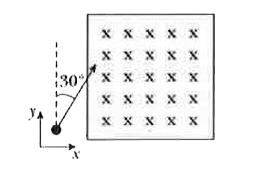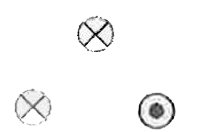Complete Solutions to Practice Question (Single Correct) of chapter MAGNETIC FIELDS DUE TO CURRENTS of Class 12 book with complete answers and questions
| Class 12 | PHYSICS |
| Chapter | MAGNETIC FIELDS DUE TO CURRENTS |
| RESNICK AND HALLIDAY | Practice Question (Single Correct) |
| Number Of Questions | 36 |
| Academic Year | 2023-24 |
A beam of proton passes undeflected with a horizontal velocity v, through a region of electric and magnetic fields, mutually perpendicular to each other and perpendicular to the direction of the beam. If the magnitudes of the electric and magnetic fields are `100kV//m`, `50mT` respectively, calculate the velocity of the beam v.
View SolutionThe magnetic field inside a solenoid is
View SolutionA solenoid of length `0.250` m and radius `0.0200` m is comprised of `120` turns of wire. Determine the magnitude of the magnetic field at the center of the solenoid when it carries a current of `15.0` A.
View SolutionA long wire is along `x = 0, z = d` and carries current in positive y direction. Another wire is along `x = y, z = 0` and carries current in direction making acute angle with positive x direction. Both the wires have current I. Find the magnitude of magnetic induction at `(0, 0, 2d)`.
View SolutionA circular loop of wire is carring a current `i` (as shown in the figure). On applying a uniform magnetic field inward perpendicular to the plane of the loop, the loop

View SolutionA small circular loop is suspended from an insulating thread. Another coaxial circular loop carrying a current I and having radius much larger than the first loop starts moving towards the smaller loop. The smaller loop will :
View SolutionTwo loops carry equal currents I in the same direction. They are held in the positions shown in the figure and project above and below the plane of the paper. The point P lies exactly halfway between them on the line that joins their centers. The centers of the loops and the point P lie in the plane of the paper. Which one of the figures below shows the position of a compass needle if the compass were placed in the plane of the paper at P ?

View SolutionAn electron is moving with a speed of `3.5xx10^(5)` m//s when it encounters a magnetic field of `0.60` T. The direction of the magnetic field makes an angle of `60.0^(@)` with respect to the velocity of the electron. What is the magnitude of the magnetic force on the electron ?
View SolutionAn electron travels through a region of space with no acceleration . Which one of the following statements is the best conclusion ?
View SolutionAn electron enters a region that contains a magnetic field directed into the page as shown. The velocity vector of the electron makes an angle of `30^(@)` with the `+y` axis. What is the direction of the magnetic force on the electron when it enters the field ?

View SolutionA wire carries current toward the north. In the region beneath this wire, What is the direction of the magnetic field due to the current ?
View SolutionTwo infinitely long perpendicular wires carry equal currents in the directions indicated in the following figure. At which of the labeled points is the magnitude of the magnetic field created by the currents the greatest ? Note: All gridlines are equally spaced.

View SolutionA circular loop is kept in that vertical plane which contains the north- south direction. It carries a current that is towards north at the topmost point. Let A be a point on the axis of the circle to the east of it and B a point on this axis to the west of it. The magnetic field due to the loop.
View SolutionA circular conductor of uniform resistance per unit length, is connected to a battery of 4 V. The total resistance of the conductor is `4omega`. The net magnetic field at the centre of the conductor is

View SolutionFigure. Shows two long wires carrying equal currents `I_1 and I_2` flowing in opposite directions. Which of the arrows labeled A to D correctely represents the direction of the magnetic field due to the wires at a point located at an equal distance d from each wire?
View SolutionRowland `(1876)` placed some charges (in a fixed location) on a nonconducting disk, which he then rotated at high speed about its central axis near a delicate compass ( as shown in the following figure ). Rowland observed that :

View SolutionConsider a long, straight wire of cross-sectional area A carrying a current i. Let there be n free electrons per unit volume. An observed places himself on a trolley moving in the direction opposite to the current with a moving in the direction opposite to the current with a speed `(v= i/nAe) and separated from the wire by a distance r. The magnetic field seen by the observer is very nearly
View SolutionFour very long straight wires carry equal electric currents in the `+z` direction. They intersect the xy plane at `(x,y)=(-a,0),(0,a),(a,0),` and `(0,-a)`. The magnetic force exerted on the wire at position `(-a,0)` is along
View SolutionCross section of three wires is shown in the following figure. If the current in the bottom two wires is opposite in direction to each other as indicated by `plus` for into the page and O for out of the page, and the top wire has current flowing into the page `plus` what is the direction of net force on the top wire ?

View SolutionConsider the situation shown in figure. The straight wire is fixed but the loop can move under magnetic force. The loop will

View SolutionTwo long straight wires, each carrying current of 5.0 A, are kept parallel to each other at a separation of 2.5 cm. The magnitude by 5.0 cm of a wire is
View SolutionIn a coaxial, straight cable, the central conductor and the outer conductor carry equal currents in opposite directions. The magnetic field is zero.
View SolutionA solenoid is connected to a battery so that a steady current flows through it. If an iron core is inserted into the solenoid, then
View SolutionA proton `(mass = 1.67xx10^(-27) kg` and charge `1.6xx10^(-19) C)` enters perpendicular to a magentic field of intensity `2 weber//m^(2)` with a speed of `2.6xx10^(7) m//sec`. The acceleration of the proton should be
View SolutionIf only `2%` of the main current is to be passed through a galvanometer of resistance `G`, then the resistance of the shunt will be
View SolutionA deutron of kinetic energy `50` keV is describing a circular orbit of radius `0.5` meter in a plane perpendicular to magnetic field `vecB`. The kinetic energy of the proton that describes a circular orbit of radius `0.5` meter in the same plane with the same `vecB` is
View SolutionA particle of charge q and mass `m` is moving along the x-axis with a velocity `v` and enters a region of electric field `E` and magnetic field `B` as shown in figures below. For which figure the net force on the charge may be zero?
View SolutionThe ratio of the magnetic field at the centre of a current carrying circular wire and the magnetic field at the centre of a square coil made from the same length of wire will be
View SolutionThe correct curve between the magnetic induction (B) along the axis of a along solenoid due to current flow i in it and distance x from one end is -
View SolutionCurrents of `10A, 2A` are passed through two parallel wires `A` and `B` respectively in opposite directions. If the wire `A` is infinitely long and the length of the wire `B` is 2 metre, the force on the conductor `B`, which is situated at `10cm` distance from `A` will be
View SolutionA current I is flowing in a conductor shaped as shown in figure. The radius of the curved part is r and length of straight portion is very large. Find the magnetic field induction at the centre O.

View SolutionA proton of mass m and charge `+e` is moving in a circular orbit in a magnetic field with energy `1 MeV`. What should be the energy of alpha-particle (mass=`4m` and charge=`+2e`), so that it can revolve in the path of same radius?
View SolutionA proton and an `alpha-`particle enter a uniform magnetic field moving with the same speed. If the proton takes `25 mu s` to make 5 revolutions, then the periodic time for the `alpha-` particle would be
View SolutionA strong magnetic field is applied on a stationary electron, then
View SolutionTwo concentric circular coils of ten turns each are situated in the same plane. Their radii are `20` and `40 cm` and they carry respectively `0.2` and `0.3` ampere current in opposite direction. The magnetic field in `Wb//m^(3)` at the centre is
View SolutionTwo insulated rings, one of a slighlty smaller diameter than the other are suspended along their common diameter as shown. Initially the planes of the rings are mutually perpendicular. When a steady current is set up each of them

View Solution
Practice Question (Single Correct) questions and complete solutions for chapter MAGNETIC FIELDS DUE TO CURRENTS of RESNICK AND HALLIDAY PHYSICS (HINGLISH) of Class 12